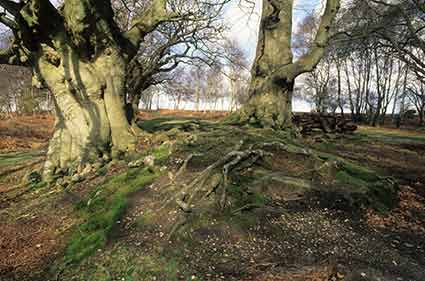The Park Pale and Lyndhurst Old Park - an overview

through by a path on the edge of Denny Inclosure
The Park Pale, south-east of Lyndhurst, is a substantial earthen bank with internal ditch. It enclosed what became known as Lyndhurst Old Park, a medieval deer park dating back to at least the 13th century – its presence was first recorded in 1291, but it was not then new.
Atop the bank would have been a paling fence, too high for even the most energetic deer to leap. Loss of 'Park' status, though, seems to have occurred in the 16th century, perhaps following reduced interest in the deer.
Today, three species of deer enjoy the freedom of the old park, all relatively unhindered. Fallow deer are most common, but roe deer occur in reasonable numbers and, very occasionally, red deer, too. Slots and droppings reveal their presence, even when the animals can not be seen.
References:
Discovering the New Forest: Terry Heathcote
Proceedings of the Hampshire Field Club & Archaeological Society, Volume 54 – The Earthwork Remains of Enclosure in the New Forest: Nicola Smith
The New Forest – A Natural History: Colin R. Tubbs
A Guide to the New Forest: Heywood Sumner
More links
Other related links
Search this site

Sadly, 58 animals were killed - 35 ponies, 13 cows, 8 donkeys and 2 sheep, whilst a further 32 were injured - 3 pigs, 9 donkeys, 11 cows and 9 ponies.
(Forty-three accidents occurred in daylight, 15 at twilight and 101 in the dark. Twenty-seven accidents were not reported by the driver involved).
Here's just one horrific example - Three donkeys killed in collision with van at notorious New Forest blackspot (Advertiser and Times)

